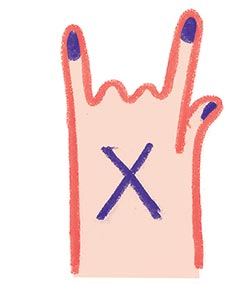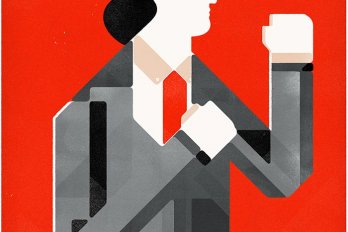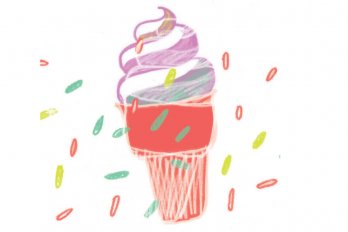Montana is a twenty-six-year-old pipefitter who lives in Fort McMurray, Alberta. Apart from a yellow parasol, electric-blue short-shorts, and flip-flops, she’s got nothing on. She and her boyfriend drove over thirteen hours to this 200-hectare farm in southeastern British Columbia’s Kootenay region, to find Shambhala, an electronic music festival that draws 10,000 visitors for five days every August. Colourful tents and throngs of concertgoers stretch through the forests and cow pastures of this wide, sweltering river valley. In the milling crowds among the vendors’ stalls, one guy holds a sign that reads, “Will trade ketamine for acid.” Others wait in line at the free on-site drug testing lab to have zip-lock bags of various powders and fistfuls of pills checked for potentially fatal ingredients. It is Montana’s second time coming to the festival, and she says she will return every year for the rest of her life. “This is the real world,” she explains. “It’s everything out there that’s messed up.”
In Tibetan Buddhist lore, the idyllic realm of Shambhala is removed from the corrupted, so-called real world. While some followers have speculated that it might have a hidden physical location, it also serves as a metaphor for spiritual enlightenment. But the Kootenays’ Shambhala belongs to a very different tradition. Inside the site’s heavily patrolled gates, virtually everything—apart from alcohol, fires, aggression, and minors—is tolerated for around $400 after parking and camping fees.
Hardcore Logos
Tattoos and secular asceticism
Jenn Kitagawa
In the ’80s, sex and drugs were integral to the cultural protest of punk in Washington, DC, but the scene also produced “straightedge,” a form of secular asceticism radically committed to abstinence’s “edge” over the mainstream. Straightedgers reject intoxication and recklessness as a socially imposed youth identity. When DC bars started marking underagers’ hands with an X, straightedge youth appropriated the distinction, tattooing their own hands, first with Sharpies, then with needles and ink. The body became a site of social protest, cleansed of toxins and marked by tattoos. The movement is inextricably tied to hardcore punk in style and militancy; hardliners, or “hate-edgers,” are known for their violent hostility toward non-believers. While some, like Vancouver artist Bif Naked, still observe the movement’s tenets, straightedge has been in decline since it began. Laser tattoo removal can always take the edge off.
—Sarah Boivin
In 1969, some 300,000 hippies gathered for a free outdoor concert at the Altamont Speedway in the San Francisco Bay Area. While the Rolling Stones played, a man was stabbed to death in front of the stage by Hells Angels hired as security. Initially dubbed “Woodstock West,” the show that saw four deaths, rumours of rape, and notoriously bad acid has since come to signify the end of an idealistic era, when it was believed that divisions between race, class, and gender could all be collapsed, and when heavy stock was placed in the word “peace.”
Vestiges of the hippie generation persisted. The Kootenay region—now renowned for its high concentration of Vietnam draft dodgers, its forty-year-old marijuana economy, and its left-wing activism—is one such enclave. I grew up here amid cultural tensions between newcomers actively trying to create an alternative world, and logging communities trying to hold on to the existing one. I attended alternative schools, potlucks, and music benefits for Guatemalan refugees. I attended parties where the high-grade strains of local weed were stronger than the acid that went around. Kids smoked pot competitively, as though being able to handle its debilitating effects was one of life’s great challenges. When I was in high school in the late ’90s, a schoolmate held the Kootenays’ first rave on his family’s vast farm: the inaugural Shambhala, where a limited supply of a new drug called ecstasy was making the rounds. Most of us had never heard of it before, and when the three-night party was over parents asked their kids what it was like.
Fifteen years later, as residents remind one another to lock their doors for the week, big city dealers come to hawk E and many other drugs. On the pathways around the farm, they call out their wares: LSD, ketamine, cocaine. Science teachers and retail workers arriving from across the country say they consider the festival a time out from their everyday lives, a moment when they get to put everything in perspective. They use terms like “freedom” and “love,” and say that everyone here respects each other. On the porta-potty doors, staff have posted a series of messages: You’re here, they exhort, because you’re someone who wants to change the world. You’re a unique soul, they say. They also give comprehensive instructions: “positive messages on consent” (don’t rape people by mistake); don’t pollute the river; and keep the grounds clean. Promoters proudly declare that their first aid zone “is actually more of a field hospital.”
As at Altamont, damage happens here; it is how it’s controlled that is different. On the fourth night, just as the sun comes up, a twenty-three-year-old man’s heart stops in the food court. Emergency response lights mingle with the laser show, and a siren cuts through the noise. Later, a first aid attendant tells me that drug use on its own doesn’t cause emergencies. Five days of drug use does.
“What if it was a ten-day event? ” I ask. “Would people go as hard? ”
“That would be a bad experiment,” he replies.
An undercover security agent on contract at the Rogers Arena, one of BC’s biggest licensed venues, says he has taken plenty of stress leave during his career. “Before I came here, I didn’t know that big crowds could have fun and not hurt each other,” he says. “People here are amazing. Look at me. I’m on the job. My hands are in my pockets.” When I ask what he attributes this to, he shrugs: “It’s something these people have done together. And there’s no alcohol.”
As the sun goes down, deep computer-generated moans rise from the trees. Crowds converge in front of colossal stages, where the bass pumps so loudly it interrupts your heartbeat. Wide-eyed dancing people grin and nod and take your hands and squeeze. In the Sanctuary zone, the overwhelmed find respite in a warmly lit shelter with batik walls and dirt floors. There, I find a man laughing hysterically and a volunteer attendant laughing along with him. A woman lies huddled on a sleeping bag on the ground. I ask an attendant what they do here, and she says that volunteers first try to find out what drugs people are on so they can relate. “We’re not qualified to analyze,” she says. “If someone believes they’ve died, we’re not qualified to tell them that it was probably just an ego death.”
The earth is vibrating, and a crowd has gathered around a propane-fuelled, fire-breathing iron dragon. For a time, I sit there cross legged as joints and small bags get passed around. Beside me, three middle-aged attendees take turns with white powder and a rolled-up bill. Strangers on the riverbank lounge together in a fifty-person hammock while others do finger painting. Beyond the trees, a muddy light seeps into the sky.
Bodies are all that remain. On the last day, as dust-covered vehicles bottleneck at the exit, legs dangle out of windows. The fields and forests are littered with the limbs of the passed-out, the nesting, the wandering dazed. Amid the exhausted exodus, I spot the yellow parasol and the proud, topless posture of a familiar form. Montana is soaking up the last moments of the thing that gets her high, before heading back to a very different world.
This appeared in the July/August 2013 issue.





